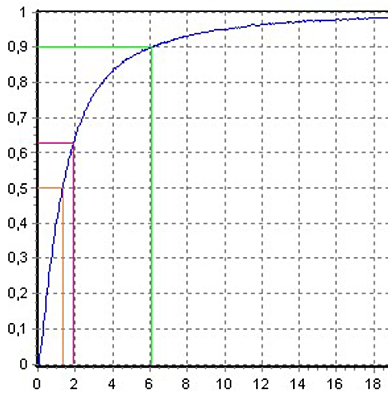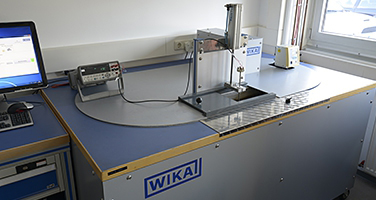
There are many reasons for using electrical thermometers with short response times: optimisation of the efficiency, more efficient utilisation of the working range of a process, avoidance of thermal overload of the process medium. But how are response times measured, what is the normative basis for them and what needs to be taken into account?

The graph shows a thermometer (red) that is too sluggish
Specially designed thermometers ensure that the measured temperature does not “lag behind” the actual process temperature. In the graph on the right, for example, the blue line corresponds to the process temperature. The red line, on the other hand, shows the temperature reading transmitted by the electrical thermometer.
Optimal design in a “fast” resistance thermometer or thermocouple is essential for a fast response time. It is also important to minimise the heat dissipation that is always present.
Determining the response times
This leads to the question of how the response times of electrical thermometers are measured and on what normative basis this is done.
Several standards and guidelines form the basis for the measurement:
- VDI/VDE 3522 sheet 1: Dynamic behaviour of contact thermometers – Principles and characteristic values
- VDI/VDE 3522 sheet 2: Dynamic behaviour of contact thermometers – Experimental determination of time percentage values
- IEC 60751: Industrial platinum resistance thermometers and platinum temperature sensors (Definition of thermal response time – Specification of measurement parameters)
In those parts of the world dominated by North America, ASTM E644-11 “Standard Test Methods for Testing Industrial Resistance Thermometers” and ASTM E839-11 “Standard Test Methods for Sheathed Thermocouples and Sheathed Thermocouple Cable”, on the other hand, form the basis of measurements and their methods of measurement.
General difference between measurement in water and in air:

Section of diagram ‘Response times’
The measurement of the response time in air is, in principle, similar to that in water. Here, too, a step change in temperature (from T1 to T2) is generated and the time delay is measured. However, the physical framework conditions – such as the heat transfer resistance of air to metal, or the specific heat capacity of air – are different from those of water. The response times in air – measured with the same thermometer – are therefore generally longer than in liquids.
Important threshold values are the temperature percentage values 50 % (t0.5), 63 % (t0.63) and 90 % (t0.9). These values indicate the time after which the test item has adjusted to 50 %, 63 % or 90 % of the water temperature or air temperature, respectively. However, the value for 100 % is not determined. Due to heat dissipation effects, this can never, in practical terms, be achieved.

Water bath with uniform, laminar flow
- Measurement of the response time in water
A pump sets uniformly tempered water into a uniform, laminar flow. The temperature-sensitive part of the test item is moved very quickly from the zone of ambient temperature (T1) to the zone of water temperature (T2) by means of a movable device (step change in temperature).

Graphical representation of the step response
The time delay (the response time) until the test item has reached the (known) water temperature is determined and recorded accordingly (step response).
Parameters for measuring medium, water (IEC 60751):
- Flow velocity vmin: 0.3 m/s ± 0.1 m/s
- Step change in temperature: 10 … 30 K
-
Measurement of the response time in air

Device for measuring the response times in air
A blower sets uniformly tempered air (T1) into a uniform (laminar) flow. The test item is mounted in a clamp in the air flow. Finally, an electric heating grid abruptly generates a higher temperature (T2) for the air flow.
Parameters for measuring medium, air (IEC 60751):
- Flow velocity vmin: 3 m/s ± 0.3 m/s
- Step change in temperature: 10 … 30 K
Note
Further information on our resistance thermometers and thermocouples can be found on the WIKA website. Would you like to buy resistance thermometers or thermocouples? In our WIKA online shop you’ll find some of our standard versions. If you have any questions, your contact will gladly help you.
Also read our posts
Temperature – what actually is it?
Heat dissipation

